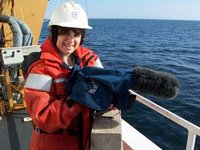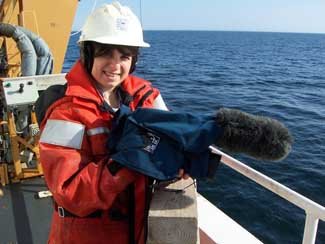Sea of the Midnight Sun
May 25th near Bering Strait

Anyone who ever waited for Santa Claus to arrive knows the excitement I’ve felt for the past 15 or so hours. We suited up in extra large dry suits and helmets for the helicopter flight from Nome to the Healy. Since this is a US Coast Guard ship, everyone working on deck or in a helicopter is required to wear certain safety equipment.
The flight took about an hour, and veteran pilot Jim pointed out wildlife along the way. From about 1500 feet aloft, however, they all resembled brown blobs. North of Nome, the landscape changed from rolling hills to flats that merged with pack ice jumbled against the coastline. A few minutes later, the ice turned into floes and then disappeared completely as we neared the ship. Jim smoothly landed us on the flight deck and we hauled our gear to our cabins. It wasn’t long after a quick dinner that I jumped donned my videographer hat.
A few minutes later, the ice turned into floes and then disappeared completely as we neared the ship. Jim smoothly landed us on the flight deck and we hauled our gear to our cabins. It wasn’t long after a quick dinner that I jumped donned my videographer hat.
Lee and Jackie planned a series of eight “stations” for the next 14 hours or so. Giant cranes and winches raise and lower equipment from the aft deck (that’s at the stern). At each station, the science team deploys water collection tubes called CTDs, which collect water at different depths for various tests in the lab. Next is a zooplankton net. This is a fine scrim cone that captures little critters free-floating in the water. The science team sifts through piles of tiny marine organisms, documenting the number, type and condition of all of the different species.(Net photo courtesey of Karen Frey.)

The van Veen grab is the third piece of equipment to go off the stern. This is a smaller version of a steam shovel. The grab does what you might think. Technicians lower this scoop to the bottom and trigger it to close and grab whatever is there: mud, rocks and marine life. The scientists empty the contents into a big bin and collect small samples in tubes. Then the mother lode is run through a scrim, so the mud is washed away, but the rocks and lifeforms remain for counting.A trawl net also goes over the side, depending on the location of the station. This net collects lots of little crabs, as well as clams and plenty of other little animals living near or on the seafloor.
In addition to Lee and Jackie’s team from the University of Tennessee, I’ve met scientists from the University of Wyoming, U Mass, Amherst and the University of Virginia. Work never stops on the Healy. It sails 24/7. Scientists are surveying and collecting around the clock. Each has a specialty: bird surveys, water chemistry, walrus observations, sediment history, etc. The data collected on this trip will be compared to data from previous and future trips to tell the story of how the Bering Sea ecology is changing over time (not much time, as it turns out).

Anyone who ever waited for Santa Claus to arrive knows the excitement I’ve felt for the past 15 or so hours. We suited up in extra large dry suits and helmets for the helicopter flight from Nome to the Healy. Since this is a US Coast Guard ship, everyone working on deck or in a helicopter is required to wear certain safety equipment.
The flight took about an hour, and veteran pilot Jim pointed out wildlife along the way. From about 1500 feet aloft, however, they all resembled brown blobs. North of Nome, the landscape changed from rolling hills to flats that merged with pack ice jumbled against the coastline.
 A few minutes later, the ice turned into floes and then disappeared completely as we neared the ship. Jim smoothly landed us on the flight deck and we hauled our gear to our cabins. It wasn’t long after a quick dinner that I jumped donned my videographer hat.
A few minutes later, the ice turned into floes and then disappeared completely as we neared the ship. Jim smoothly landed us on the flight deck and we hauled our gear to our cabins. It wasn’t long after a quick dinner that I jumped donned my videographer hat.Lee and Jackie planned a series of eight “stations” for the next 14 hours or so. Giant cranes and winches raise and lower equipment from the aft deck (that’s at the stern). At each station, the science team deploys water collection tubes called CTDs, which collect water at different depths for various tests in the lab. Next is a zooplankton net. This is a fine scrim cone that captures little critters free-floating in the water. The science team sifts through piles of tiny marine organisms, documenting the number, type and condition of all of the different species.(Net photo courtesey of Karen Frey.)

The van Veen grab is the third piece of equipment to go off the stern. This is a smaller version of a steam shovel. The grab does what you might think. Technicians lower this scoop to the bottom and trigger it to close and grab whatever is there: mud, rocks and marine life. The scientists empty the contents into a big bin and collect small samples in tubes. Then the mother lode is run through a scrim, so the mud is washed away, but the rocks and lifeforms remain for counting.A trawl net also goes over the side, depending on the location of the station. This net collects lots of little crabs, as well as clams and plenty of other little animals living near or on the seafloor.
In addition to Lee and Jackie’s team from the University of Tennessee, I’ve met scientists from the University of Wyoming, U Mass, Amherst and the University of Virginia. Work never stops on the Healy. It sails 24/7. Scientists are surveying and collecting around the clock. Each has a specialty: bird surveys, water chemistry, walrus observations, sediment history, etc. The data collected on this trip will be compared to data from previous and future trips to tell the story of how the Bering Sea ecology is changing over time (not much time, as it turns out).


1 Comments:
Thanks for taking us along on the trip. It's very exciting to read the latest entries. The pictures are really beautiful.
I particularly liked the international dateline discussion.
Mothen
Post a Comment
<< Home